Research Report: Cyber Threats to Marketing Companies in Australia
VerifiedAdded on 2023/04/26
|17
|3888
|263
Report
AI Summary
This research report delves into the impact of cyber threats on consumer goods companies in Australia, examining the challenges they face due to data loss and the methods used to analyze secondary data. It discusses the importance of confidential market information, the negative connection between cyber-attacks and the future of multinational companies, and offers recommendations for mitigating these threats. The report uses interpretivism to analyze qualitative data and suggests innovative measures to curb cyber-attacks. It also addresses the limitations of existing research and proposes solutions for stopping online attacks, emphasizing the need for companies to regain consumer trust and maintain vigilance over confidential information. Desklib provides this and other solved assignments to help students in their academic journey.
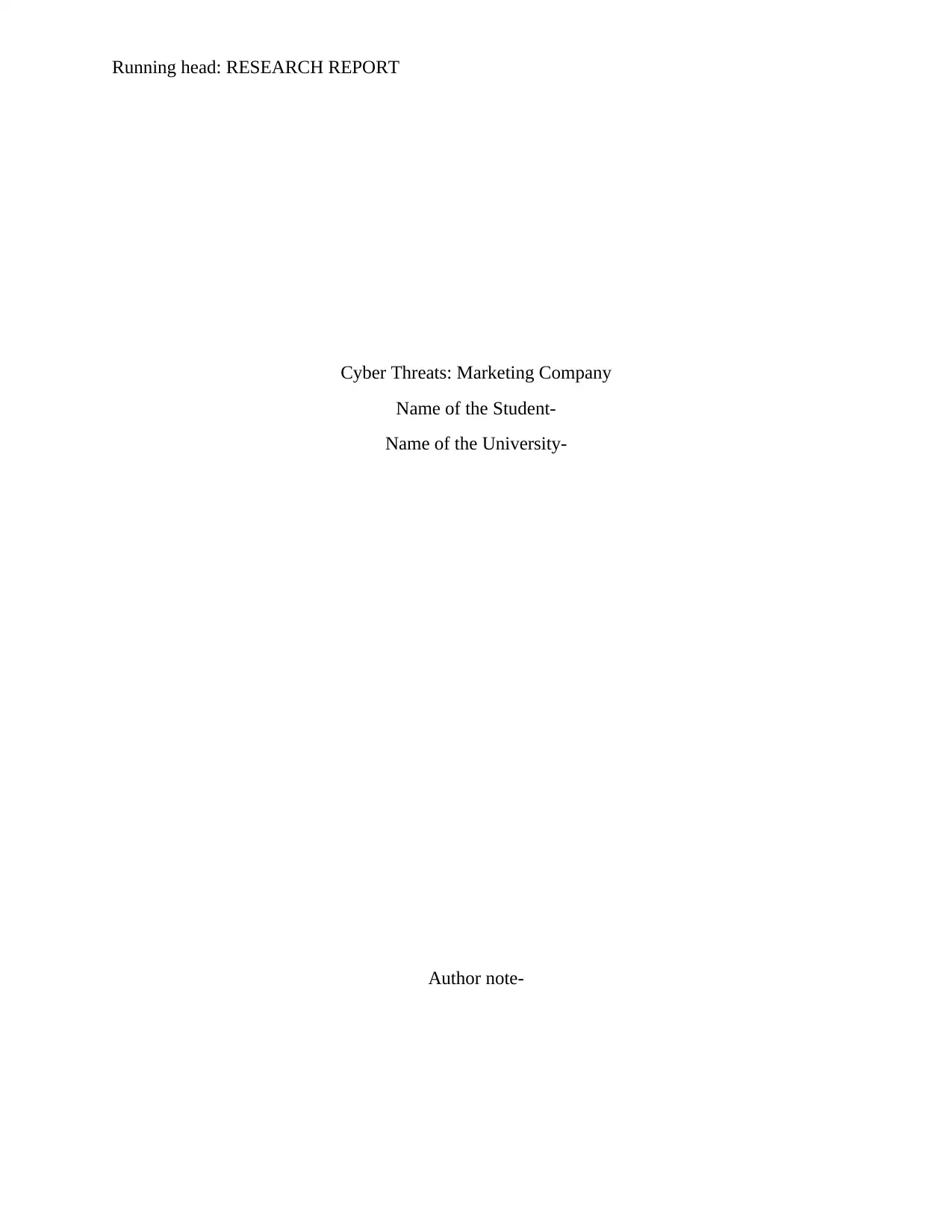
Running head: RESEARCH REPORT
Cyber Threats: Marketing Company
Name of the Student-
Name of the University-
Author note-
Cyber Threats: Marketing Company
Name of the Student-
Name of the University-
Author note-
Paraphrase This Document
Need a fresh take? Get an instant paraphrase of this document with our AI Paraphraser
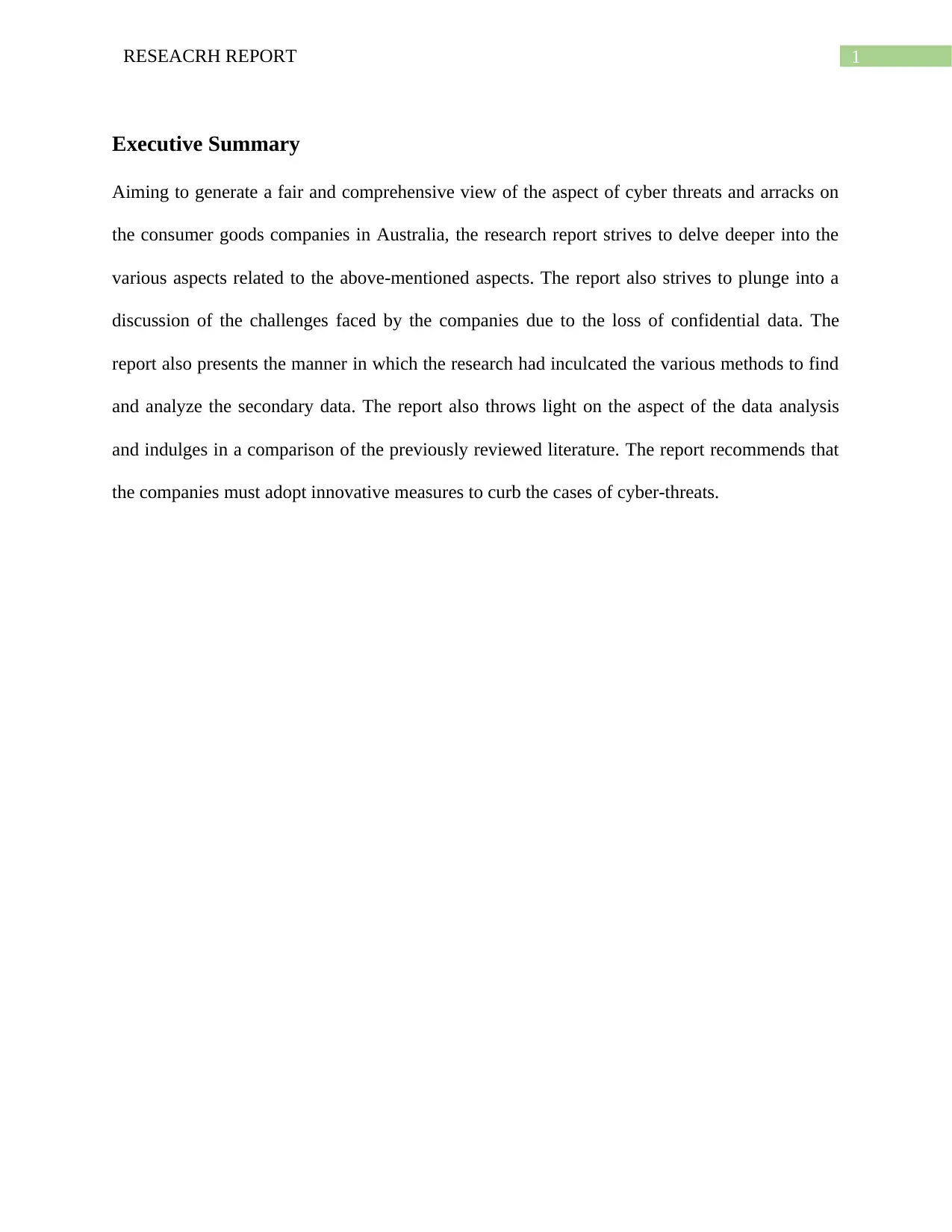
1RESEACRH REPORT
Executive Summary
Aiming to generate a fair and comprehensive view of the aspect of cyber threats and arracks on
the consumer goods companies in Australia, the research report strives to delve deeper into the
various aspects related to the above-mentioned aspects. The report also strives to plunge into a
discussion of the challenges faced by the companies due to the loss of confidential data. The
report also presents the manner in which the research had inculcated the various methods to find
and analyze the secondary data. The report also throws light on the aspect of the data analysis
and indulges in a comparison of the previously reviewed literature. The report recommends that
the companies must adopt innovative measures to curb the cases of cyber-threats.
Executive Summary
Aiming to generate a fair and comprehensive view of the aspect of cyber threats and arracks on
the consumer goods companies in Australia, the research report strives to delve deeper into the
various aspects related to the above-mentioned aspects. The report also strives to plunge into a
discussion of the challenges faced by the companies due to the loss of confidential data. The
report also presents the manner in which the research had inculcated the various methods to find
and analyze the secondary data. The report also throws light on the aspect of the data analysis
and indulges in a comparison of the previously reviewed literature. The report recommends that
the companies must adopt innovative measures to curb the cases of cyber-threats.
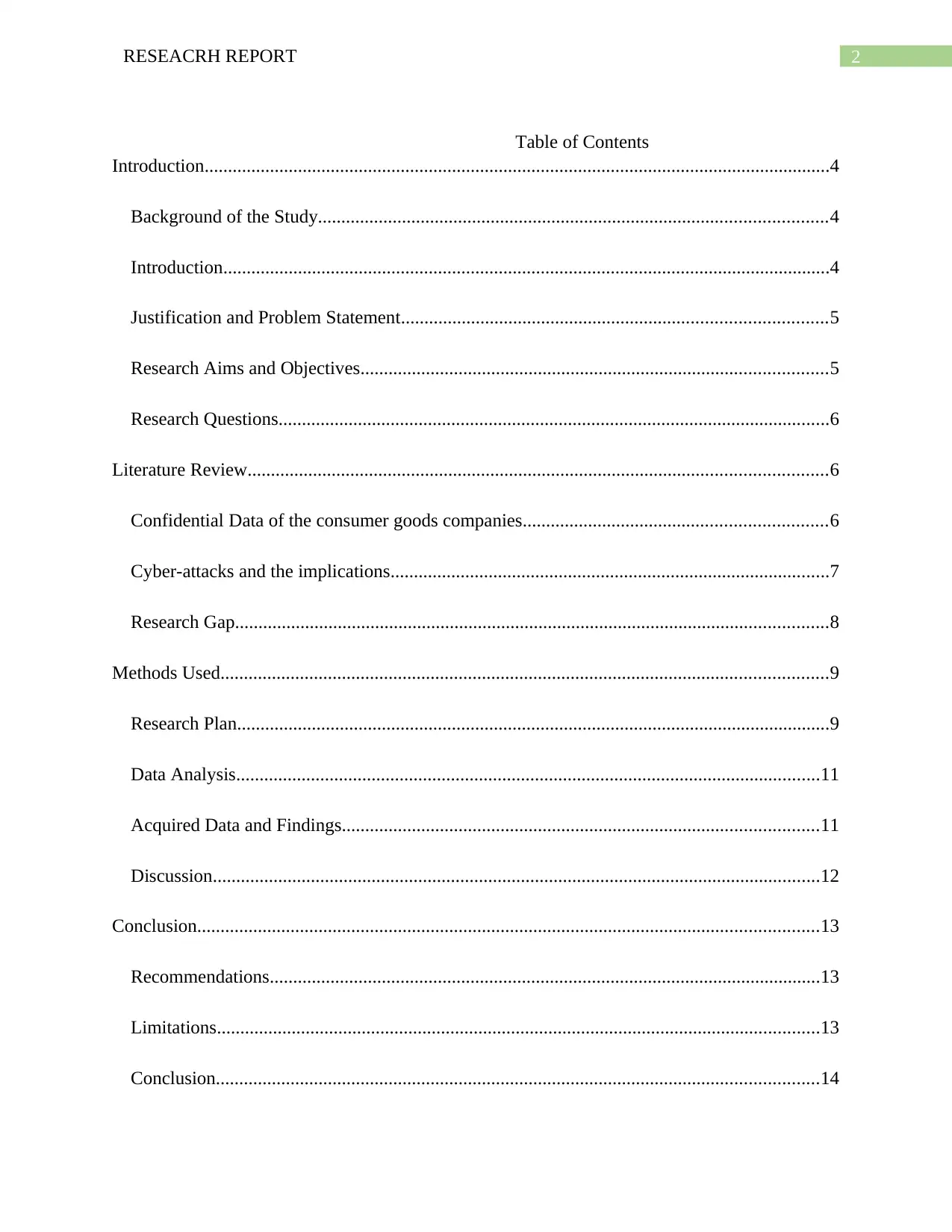
2RESEACRH REPORT
Table of Contents
Introduction......................................................................................................................................4
Background of the Study.............................................................................................................4
Introduction..................................................................................................................................4
Justification and Problem Statement...........................................................................................5
Research Aims and Objectives....................................................................................................5
Research Questions......................................................................................................................6
Literature Review............................................................................................................................6
Confidential Data of the consumer goods companies.................................................................6
Cyber-attacks and the implications..............................................................................................7
Research Gap...............................................................................................................................8
Methods Used..................................................................................................................................9
Research Plan...............................................................................................................................9
Data Analysis.............................................................................................................................11
Acquired Data and Findings......................................................................................................11
Discussion..................................................................................................................................12
Conclusion.....................................................................................................................................13
Recommendations......................................................................................................................13
Limitations.................................................................................................................................13
Conclusion.................................................................................................................................14
Table of Contents
Introduction......................................................................................................................................4
Background of the Study.............................................................................................................4
Introduction..................................................................................................................................4
Justification and Problem Statement...........................................................................................5
Research Aims and Objectives....................................................................................................5
Research Questions......................................................................................................................6
Literature Review............................................................................................................................6
Confidential Data of the consumer goods companies.................................................................6
Cyber-attacks and the implications..............................................................................................7
Research Gap...............................................................................................................................8
Methods Used..................................................................................................................................9
Research Plan...............................................................................................................................9
Data Analysis.............................................................................................................................11
Acquired Data and Findings......................................................................................................11
Discussion..................................................................................................................................12
Conclusion.....................................................................................................................................13
Recommendations......................................................................................................................13
Limitations.................................................................................................................................13
Conclusion.................................................................................................................................14
⊘ This is a preview!⊘
Do you want full access?
Subscribe today to unlock all pages.

Trusted by 1+ million students worldwide
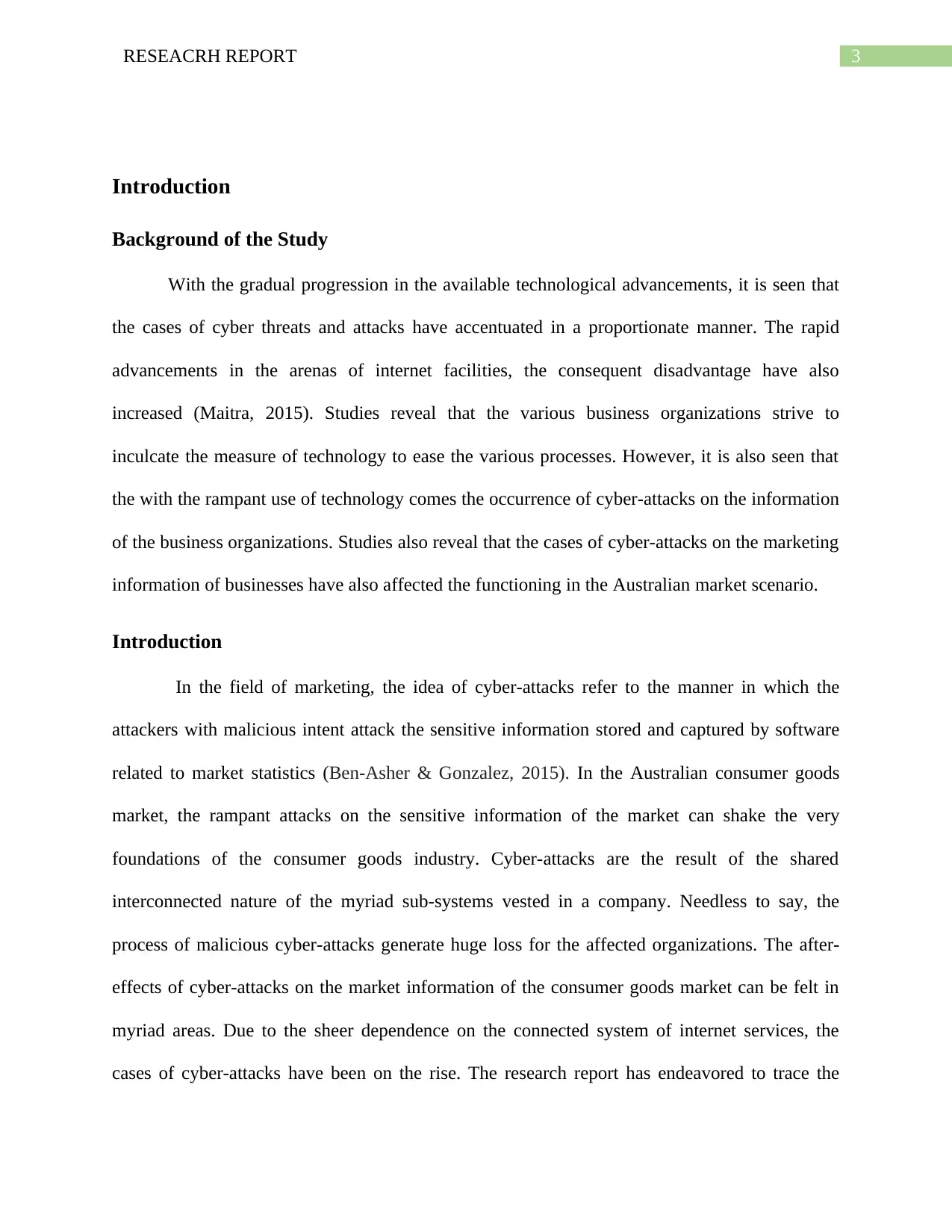
3RESEACRH REPORT
Introduction
Background of the Study
With the gradual progression in the available technological advancements, it is seen that
the cases of cyber threats and attacks have accentuated in a proportionate manner. The rapid
advancements in the arenas of internet facilities, the consequent disadvantage have also
increased (Maitra, 2015). Studies reveal that the various business organizations strive to
inculcate the measure of technology to ease the various processes. However, it is also seen that
the with the rampant use of technology comes the occurrence of cyber-attacks on the information
of the business organizations. Studies also reveal that the cases of cyber-attacks on the marketing
information of businesses have also affected the functioning in the Australian market scenario.
Introduction
In the field of marketing, the idea of cyber-attacks refer to the manner in which the
attackers with malicious intent attack the sensitive information stored and captured by software
related to market statistics (Ben-Asher & Gonzalez, 2015). In the Australian consumer goods
market, the rampant attacks on the sensitive information of the market can shake the very
foundations of the consumer goods industry. Cyber-attacks are the result of the shared
interconnected nature of the myriad sub-systems vested in a company. Needless to say, the
process of malicious cyber-attacks generate huge loss for the affected organizations. The after-
effects of cyber-attacks on the market information of the consumer goods market can be felt in
myriad areas. Due to the sheer dependence on the connected system of internet services, the
cases of cyber-attacks have been on the rise. The research report has endeavored to trace the
Introduction
Background of the Study
With the gradual progression in the available technological advancements, it is seen that
the cases of cyber threats and attacks have accentuated in a proportionate manner. The rapid
advancements in the arenas of internet facilities, the consequent disadvantage have also
increased (Maitra, 2015). Studies reveal that the various business organizations strive to
inculcate the measure of technology to ease the various processes. However, it is also seen that
the with the rampant use of technology comes the occurrence of cyber-attacks on the information
of the business organizations. Studies also reveal that the cases of cyber-attacks on the marketing
information of businesses have also affected the functioning in the Australian market scenario.
Introduction
In the field of marketing, the idea of cyber-attacks refer to the manner in which the
attackers with malicious intent attack the sensitive information stored and captured by software
related to market statistics (Ben-Asher & Gonzalez, 2015). In the Australian consumer goods
market, the rampant attacks on the sensitive information of the market can shake the very
foundations of the consumer goods industry. Cyber-attacks are the result of the shared
interconnected nature of the myriad sub-systems vested in a company. Needless to say, the
process of malicious cyber-attacks generate huge loss for the affected organizations. The after-
effects of cyber-attacks on the market information of the consumer goods market can be felt in
myriad areas. Due to the sheer dependence on the connected system of internet services, the
cases of cyber-attacks have been on the rise. The research report has endeavored to trace the
Paraphrase This Document
Need a fresh take? Get an instant paraphrase of this document with our AI Paraphraser
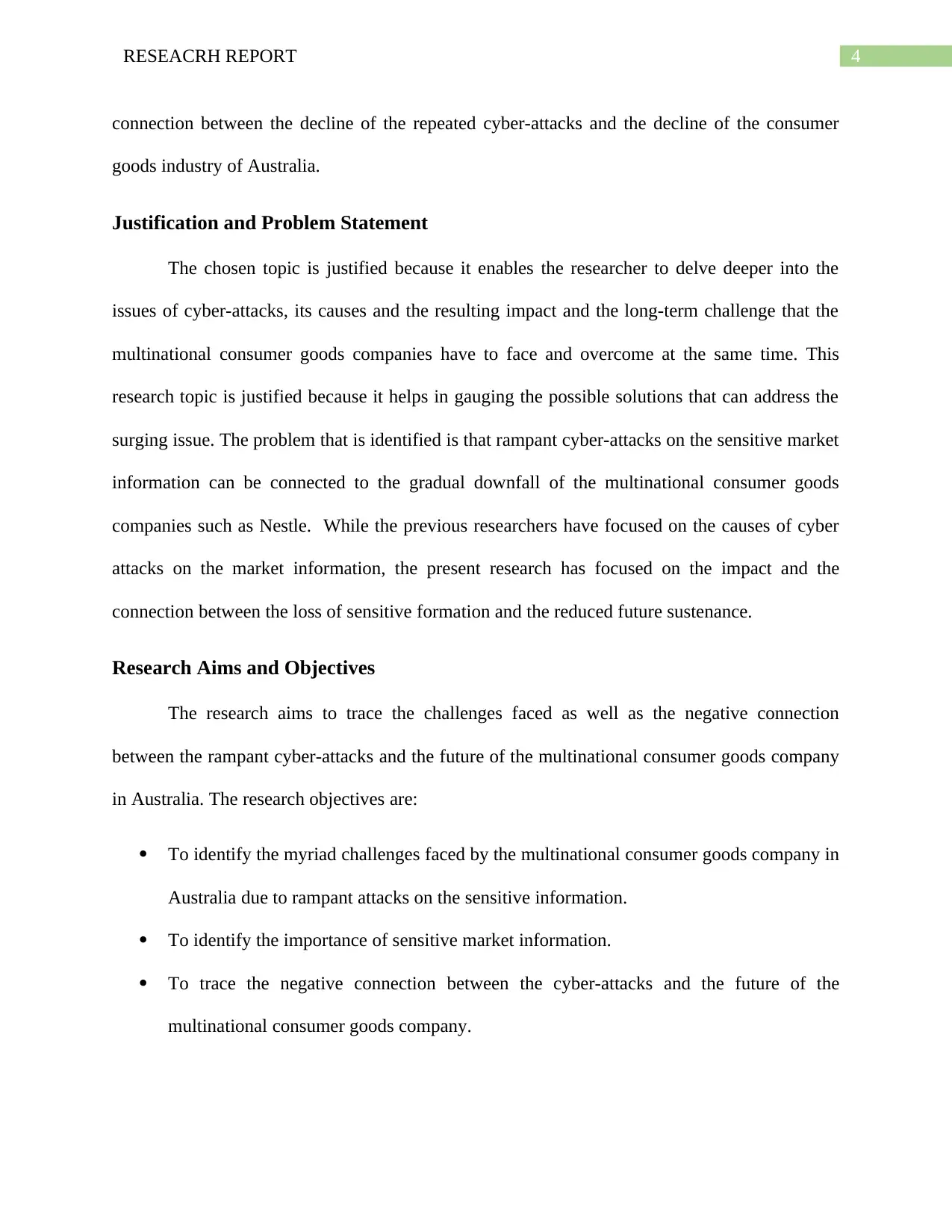
4RESEACRH REPORT
connection between the decline of the repeated cyber-attacks and the decline of the consumer
goods industry of Australia.
Justification and Problem Statement
The chosen topic is justified because it enables the researcher to delve deeper into the
issues of cyber-attacks, its causes and the resulting impact and the long-term challenge that the
multinational consumer goods companies have to face and overcome at the same time. This
research topic is justified because it helps in gauging the possible solutions that can address the
surging issue. The problem that is identified is that rampant cyber-attacks on the sensitive market
information can be connected to the gradual downfall of the multinational consumer goods
companies such as Nestle. While the previous researchers have focused on the causes of cyber
attacks on the market information, the present research has focused on the impact and the
connection between the loss of sensitive formation and the reduced future sustenance.
Research Aims and Objectives
The research aims to trace the challenges faced as well as the negative connection
between the rampant cyber-attacks and the future of the multinational consumer goods company
in Australia. The research objectives are:
To identify the myriad challenges faced by the multinational consumer goods company in
Australia due to rampant attacks on the sensitive information.
To identify the importance of sensitive market information.
To trace the negative connection between the cyber-attacks and the future of the
multinational consumer goods company.
connection between the decline of the repeated cyber-attacks and the decline of the consumer
goods industry of Australia.
Justification and Problem Statement
The chosen topic is justified because it enables the researcher to delve deeper into the
issues of cyber-attacks, its causes and the resulting impact and the long-term challenge that the
multinational consumer goods companies have to face and overcome at the same time. This
research topic is justified because it helps in gauging the possible solutions that can address the
surging issue. The problem that is identified is that rampant cyber-attacks on the sensitive market
information can be connected to the gradual downfall of the multinational consumer goods
companies such as Nestle. While the previous researchers have focused on the causes of cyber
attacks on the market information, the present research has focused on the impact and the
connection between the loss of sensitive formation and the reduced future sustenance.
Research Aims and Objectives
The research aims to trace the challenges faced as well as the negative connection
between the rampant cyber-attacks and the future of the multinational consumer goods company
in Australia. The research objectives are:
To identify the myriad challenges faced by the multinational consumer goods company in
Australia due to rampant attacks on the sensitive information.
To identify the importance of sensitive market information.
To trace the negative connection between the cyber-attacks and the future of the
multinational consumer goods company.
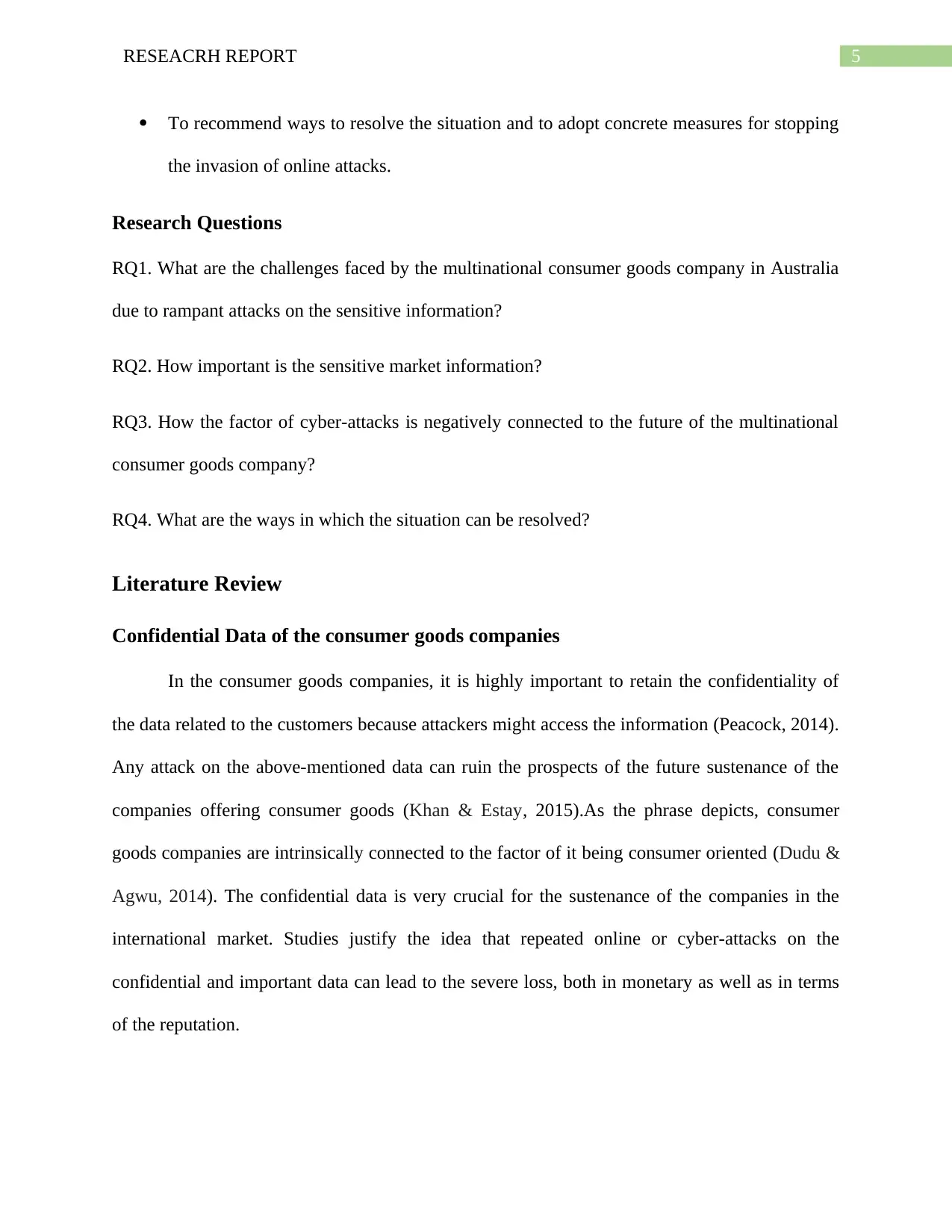
5RESEACRH REPORT
To recommend ways to resolve the situation and to adopt concrete measures for stopping
the invasion of online attacks.
Research Questions
RQ1. What are the challenges faced by the multinational consumer goods company in Australia
due to rampant attacks on the sensitive information?
RQ2. How important is the sensitive market information?
RQ3. How the factor of cyber-attacks is negatively connected to the future of the multinational
consumer goods company?
RQ4. What are the ways in which the situation can be resolved?
Literature Review
Confidential Data of the consumer goods companies
In the consumer goods companies, it is highly important to retain the confidentiality of
the data related to the customers because attackers might access the information (Peacock, 2014).
Any attack on the above-mentioned data can ruin the prospects of the future sustenance of the
companies offering consumer goods (Khan & Estay, 2015).As the phrase depicts, consumer
goods companies are intrinsically connected to the factor of it being consumer oriented (Dudu &
Agwu, 2014). The confidential data is very crucial for the sustenance of the companies in the
international market. Studies justify the idea that repeated online or cyber-attacks on the
confidential and important data can lead to the severe loss, both in monetary as well as in terms
of the reputation.
To recommend ways to resolve the situation and to adopt concrete measures for stopping
the invasion of online attacks.
Research Questions
RQ1. What are the challenges faced by the multinational consumer goods company in Australia
due to rampant attacks on the sensitive information?
RQ2. How important is the sensitive market information?
RQ3. How the factor of cyber-attacks is negatively connected to the future of the multinational
consumer goods company?
RQ4. What are the ways in which the situation can be resolved?
Literature Review
Confidential Data of the consumer goods companies
In the consumer goods companies, it is highly important to retain the confidentiality of
the data related to the customers because attackers might access the information (Peacock, 2014).
Any attack on the above-mentioned data can ruin the prospects of the future sustenance of the
companies offering consumer goods (Khan & Estay, 2015).As the phrase depicts, consumer
goods companies are intrinsically connected to the factor of it being consumer oriented (Dudu &
Agwu, 2014). The confidential data is very crucial for the sustenance of the companies in the
international market. Studies justify the idea that repeated online or cyber-attacks on the
confidential and important data can lead to the severe loss, both in monetary as well as in terms
of the reputation.
⊘ This is a preview!⊘
Do you want full access?
Subscribe today to unlock all pages.

Trusted by 1+ million students worldwide
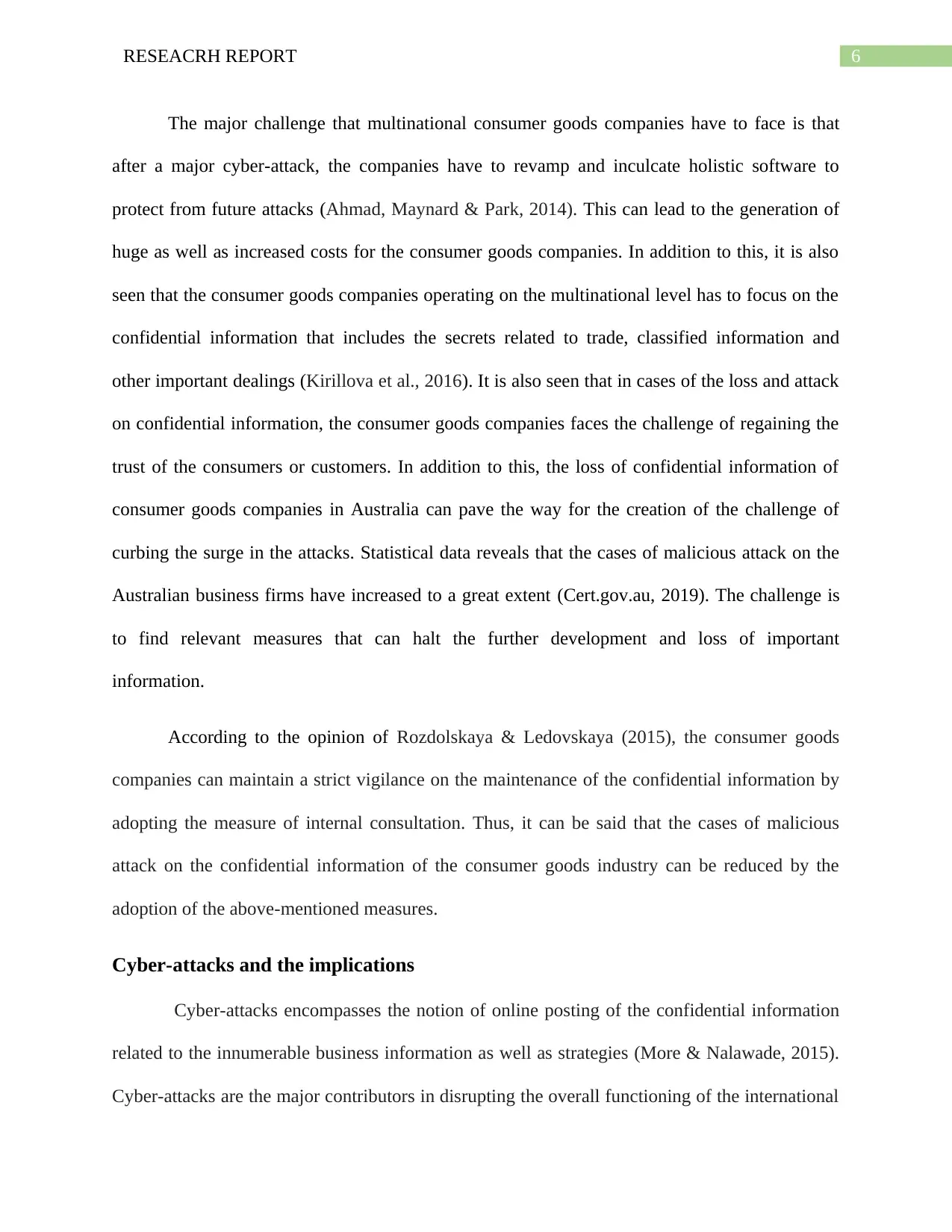
6RESEACRH REPORT
The major challenge that multinational consumer goods companies have to face is that
after a major cyber-attack, the companies have to revamp and inculcate holistic software to
protect from future attacks (Ahmad, Maynard & Park, 2014). This can lead to the generation of
huge as well as increased costs for the consumer goods companies. In addition to this, it is also
seen that the consumer goods companies operating on the multinational level has to focus on the
confidential information that includes the secrets related to trade, classified information and
other important dealings (Kirillova et al., 2016). It is also seen that in cases of the loss and attack
on confidential information, the consumer goods companies faces the challenge of regaining the
trust of the consumers or customers. In addition to this, the loss of confidential information of
consumer goods companies in Australia can pave the way for the creation of the challenge of
curbing the surge in the attacks. Statistical data reveals that the cases of malicious attack on the
Australian business firms have increased to a great extent (Cert.gov.au, 2019). The challenge is
to find relevant measures that can halt the further development and loss of important
information.
According to the opinion of Rozdolskaya & Ledovskaya (2015), the consumer goods
companies can maintain a strict vigilance on the maintenance of the confidential information by
adopting the measure of internal consultation. Thus, it can be said that the cases of malicious
attack on the confidential information of the consumer goods industry can be reduced by the
adoption of the above-mentioned measures.
Cyber-attacks and the implications
Cyber-attacks encompasses the notion of online posting of the confidential information
related to the innumerable business information as well as strategies (More & Nalawade, 2015).
Cyber-attacks are the major contributors in disrupting the overall functioning of the international
The major challenge that multinational consumer goods companies have to face is that
after a major cyber-attack, the companies have to revamp and inculcate holistic software to
protect from future attacks (Ahmad, Maynard & Park, 2014). This can lead to the generation of
huge as well as increased costs for the consumer goods companies. In addition to this, it is also
seen that the consumer goods companies operating on the multinational level has to focus on the
confidential information that includes the secrets related to trade, classified information and
other important dealings (Kirillova et al., 2016). It is also seen that in cases of the loss and attack
on confidential information, the consumer goods companies faces the challenge of regaining the
trust of the consumers or customers. In addition to this, the loss of confidential information of
consumer goods companies in Australia can pave the way for the creation of the challenge of
curbing the surge in the attacks. Statistical data reveals that the cases of malicious attack on the
Australian business firms have increased to a great extent (Cert.gov.au, 2019). The challenge is
to find relevant measures that can halt the further development and loss of important
information.
According to the opinion of Rozdolskaya & Ledovskaya (2015), the consumer goods
companies can maintain a strict vigilance on the maintenance of the confidential information by
adopting the measure of internal consultation. Thus, it can be said that the cases of malicious
attack on the confidential information of the consumer goods industry can be reduced by the
adoption of the above-mentioned measures.
Cyber-attacks and the implications
Cyber-attacks encompasses the notion of online posting of the confidential information
related to the innumerable business information as well as strategies (More & Nalawade, 2015).
Cyber-attacks are the major contributors in disrupting the overall functioning of the international
Paraphrase This Document
Need a fresh take? Get an instant paraphrase of this document with our AI Paraphraser

7RESEACRH REPORT
consumer goods companies in Australia. The need of the hour is to keep a track of the number of
attacks (Gao & Morris, 2014).Studies are emblematic of the fact that major cyber- attacks can
pave the way for the future disruption of the consumer goods companies. Studies have also
presented that increase in the degree of the cyber-attacks can pave the way for extreme financial
loss (Biener, Eling & Wirfs, 2018). In addition to this, the cyber-attacks on the consumer goods
industries can have a considerable impact on the function of the companies and pose a risk for
the various future endeavors because there is a loss of intellectual properties (Toregas & Zahn,
2014). The impact of the cyber-attacks on the consumer goods multinational companies are
severe and yields a long-term impact (Rid & Buchanan, 2015). Further, it is seen that the cases of
cyber-attack can negatively impact the progression of the consumer good enterprises because
major breach of confidential information leads to the breach of trust amongst the consumer base
and results in the generation of a tarnished reputation (Arlitsch & Edelman, 2014). Additionally,
it is also seen that the aspect of cyber threats can negatively impact the level of the productivity
of the consumer goods companies and severely affect the confidence vested by the stakeholders
upon the affected companies (Arcuri, Brogi & Gandolfi, 2014).
Research Gap
It can be said that though there are innumerable studies available for stating the causes of
the increase in cyber-attacks on the international consumer goods companies, it has to be
mentioned that these studies have failed to encompass the area of tracing the exact challenges
that have to be faced by the companies. In addition to this, the previous researches have also
failed to encompass the idea of searching for resolutions that can halt the process of surging
cyber and malicious attacks on the market and confidential information. A closer analysis will
reveal that the prevalent available literatures do not explore the negative relations between the
consumer goods companies in Australia. The need of the hour is to keep a track of the number of
attacks (Gao & Morris, 2014).Studies are emblematic of the fact that major cyber- attacks can
pave the way for the future disruption of the consumer goods companies. Studies have also
presented that increase in the degree of the cyber-attacks can pave the way for extreme financial
loss (Biener, Eling & Wirfs, 2018). In addition to this, the cyber-attacks on the consumer goods
industries can have a considerable impact on the function of the companies and pose a risk for
the various future endeavors because there is a loss of intellectual properties (Toregas & Zahn,
2014). The impact of the cyber-attacks on the consumer goods multinational companies are
severe and yields a long-term impact (Rid & Buchanan, 2015). Further, it is seen that the cases of
cyber-attack can negatively impact the progression of the consumer good enterprises because
major breach of confidential information leads to the breach of trust amongst the consumer base
and results in the generation of a tarnished reputation (Arlitsch & Edelman, 2014). Additionally,
it is also seen that the aspect of cyber threats can negatively impact the level of the productivity
of the consumer goods companies and severely affect the confidence vested by the stakeholders
upon the affected companies (Arcuri, Brogi & Gandolfi, 2014).
Research Gap
It can be said that though there are innumerable studies available for stating the causes of
the increase in cyber-attacks on the international consumer goods companies, it has to be
mentioned that these studies have failed to encompass the area of tracing the exact challenges
that have to be faced by the companies. In addition to this, the previous researches have also
failed to encompass the idea of searching for resolutions that can halt the process of surging
cyber and malicious attacks on the market and confidential information. A closer analysis will
reveal that the prevalent available literatures do not explore the negative relations between the

8RESEACRH REPORT
cyber-attacks and the future sustenance of the company. Therefore, the following study has
resolved to determine and adjudge the challenges that are faced by consumer goods companies
after the occurrence of loss of confidential data.
Methods Used
To carry out the project and to proceed with the research, the researcher had endeavored
to include the relevant methodology. To arrive at the proper results, the research had include the
philosophy of interpretivism. The philosophy of interpretivism had helped the research in finding
the data in a proper and detailed manner. The philosophy of interpretivism had been adopted to
interpret the available data to reach at the conclusion. The philosophy of interpretivism had
assisted the researcher in indulging in an in-depth analysis and interpretation of the acquired data
and information. According to the opinion of Howe (2014), the philosophy and approach of
interretivism helps in the analysis of the qualitative data. Likewise, in this research, the
researcher had endeavored to inculcate this measure to encompass the notion of the existence of
different forms of truths. This philosophy had been chosen and is justified because as against the
philosophy of positivism, interpretvism chiefly focuses on the subjective existence of reality and
the concept of internal conceptions of reality (Khan, 2014). Coupled by this, the research had
also focused on the inculcation of relevant measures.
Research Plan
The research objectives and questions were framed after an in-depth reading of the
secondary sources. Secondary sources of information consists of the various readings, resources,
article as well as journals (). The research questions were farmed after a closer look at the
articles. In addition to this, the research had also focused on the accumulation of the relevant
secondary sources by segregating the relevant ones from the others. To sort the relevant ones, the
cyber-attacks and the future sustenance of the company. Therefore, the following study has
resolved to determine and adjudge the challenges that are faced by consumer goods companies
after the occurrence of loss of confidential data.
Methods Used
To carry out the project and to proceed with the research, the researcher had endeavored
to include the relevant methodology. To arrive at the proper results, the research had include the
philosophy of interpretivism. The philosophy of interpretivism had helped the research in finding
the data in a proper and detailed manner. The philosophy of interpretivism had been adopted to
interpret the available data to reach at the conclusion. The philosophy of interpretivism had
assisted the researcher in indulging in an in-depth analysis and interpretation of the acquired data
and information. According to the opinion of Howe (2014), the philosophy and approach of
interretivism helps in the analysis of the qualitative data. Likewise, in this research, the
researcher had endeavored to inculcate this measure to encompass the notion of the existence of
different forms of truths. This philosophy had been chosen and is justified because as against the
philosophy of positivism, interpretvism chiefly focuses on the subjective existence of reality and
the concept of internal conceptions of reality (Khan, 2014). Coupled by this, the research had
also focused on the inculcation of relevant measures.
Research Plan
The research objectives and questions were framed after an in-depth reading of the
secondary sources. Secondary sources of information consists of the various readings, resources,
article as well as journals (). The research questions were farmed after a closer look at the
articles. In addition to this, the research had also focused on the accumulation of the relevant
secondary sources by segregating the relevant ones from the others. To sort the relevant ones, the
⊘ This is a preview!⊘
Do you want full access?
Subscribe today to unlock all pages.

Trusted by 1+ million students worldwide

9RESEACRH REPORT
research had tried to base and relate each secondary source to the topic concerned. The research
had also followed a concrete plan starting from the acquiring of data to the formulation of final
report.
Research Activities Week
(1-3)
Week
(4-10)
Week
(11-
13)
Week
(14-17)
Week
(18-21)
Week
(22-
23)
Week
24
Topic selection
Data collection –
Secondary
Layout of the research
Literature review of the
research
Interpretation and
analysis of collected data
Findings
Conclusion
Draft formation
Submission
Figure: The Gantt chart
Source: (created by the author)
research had tried to base and relate each secondary source to the topic concerned. The research
had also followed a concrete plan starting from the acquiring of data to the formulation of final
report.
Research Activities Week
(1-3)
Week
(4-10)
Week
(11-
13)
Week
(14-17)
Week
(18-21)
Week
(22-
23)
Week
24
Topic selection
Data collection –
Secondary
Layout of the research
Literature review of the
research
Interpretation and
analysis of collected data
Findings
Conclusion
Draft formation
Submission
Figure: The Gantt chart
Source: (created by the author)
Paraphrase This Document
Need a fresh take? Get an instant paraphrase of this document with our AI Paraphraser
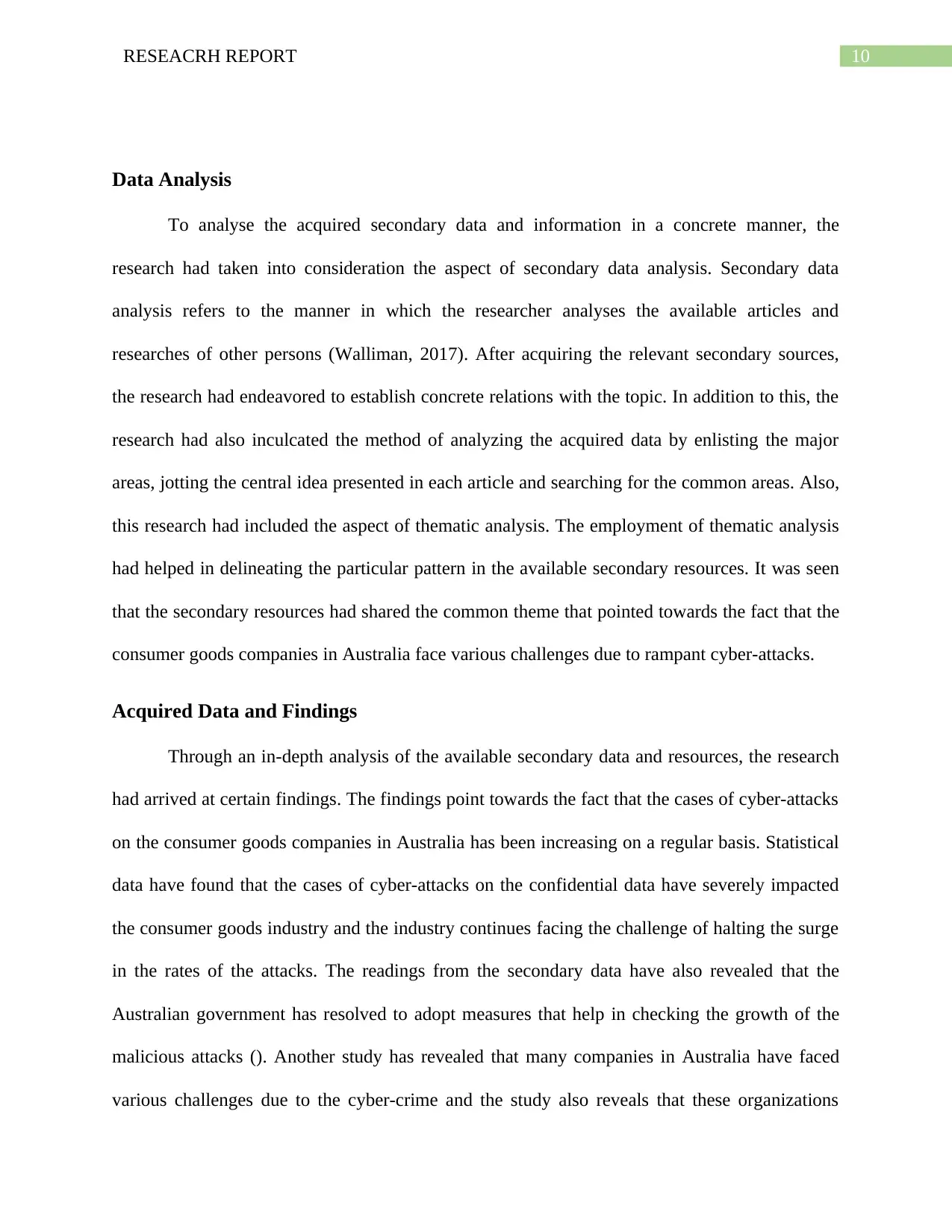
10RESEACRH REPORT
Data Analysis
To analyse the acquired secondary data and information in a concrete manner, the
research had taken into consideration the aspect of secondary data analysis. Secondary data
analysis refers to the manner in which the researcher analyses the available articles and
researches of other persons (Walliman, 2017). After acquiring the relevant secondary sources,
the research had endeavored to establish concrete relations with the topic. In addition to this, the
research had also inculcated the method of analyzing the acquired data by enlisting the major
areas, jotting the central idea presented in each article and searching for the common areas. Also,
this research had included the aspect of thematic analysis. The employment of thematic analysis
had helped in delineating the particular pattern in the available secondary resources. It was seen
that the secondary resources had shared the common theme that pointed towards the fact that the
consumer goods companies in Australia face various challenges due to rampant cyber-attacks.
Acquired Data and Findings
Through an in-depth analysis of the available secondary data and resources, the research
had arrived at certain findings. The findings point towards the fact that the cases of cyber-attacks
on the consumer goods companies in Australia has been increasing on a regular basis. Statistical
data have found that the cases of cyber-attacks on the confidential data have severely impacted
the consumer goods industry and the industry continues facing the challenge of halting the surge
in the rates of the attacks. The readings from the secondary data have also revealed that the
Australian government has resolved to adopt measures that help in checking the growth of the
malicious attacks (). Another study has revealed that many companies in Australia have faced
various challenges due to the cyber-crime and the study also reveals that these organizations
Data Analysis
To analyse the acquired secondary data and information in a concrete manner, the
research had taken into consideration the aspect of secondary data analysis. Secondary data
analysis refers to the manner in which the researcher analyses the available articles and
researches of other persons (Walliman, 2017). After acquiring the relevant secondary sources,
the research had endeavored to establish concrete relations with the topic. In addition to this, the
research had also inculcated the method of analyzing the acquired data by enlisting the major
areas, jotting the central idea presented in each article and searching for the common areas. Also,
this research had included the aspect of thematic analysis. The employment of thematic analysis
had helped in delineating the particular pattern in the available secondary resources. It was seen
that the secondary resources had shared the common theme that pointed towards the fact that the
consumer goods companies in Australia face various challenges due to rampant cyber-attacks.
Acquired Data and Findings
Through an in-depth analysis of the available secondary data and resources, the research
had arrived at certain findings. The findings point towards the fact that the cases of cyber-attacks
on the consumer goods companies in Australia has been increasing on a regular basis. Statistical
data have found that the cases of cyber-attacks on the confidential data have severely impacted
the consumer goods industry and the industry continues facing the challenge of halting the surge
in the rates of the attacks. The readings from the secondary data have also revealed that the
Australian government has resolved to adopt measures that help in checking the growth of the
malicious attacks (). Another study has revealed that many companies in Australia have faced
various challenges due to the cyber-crime and the study also reveals that these organizations
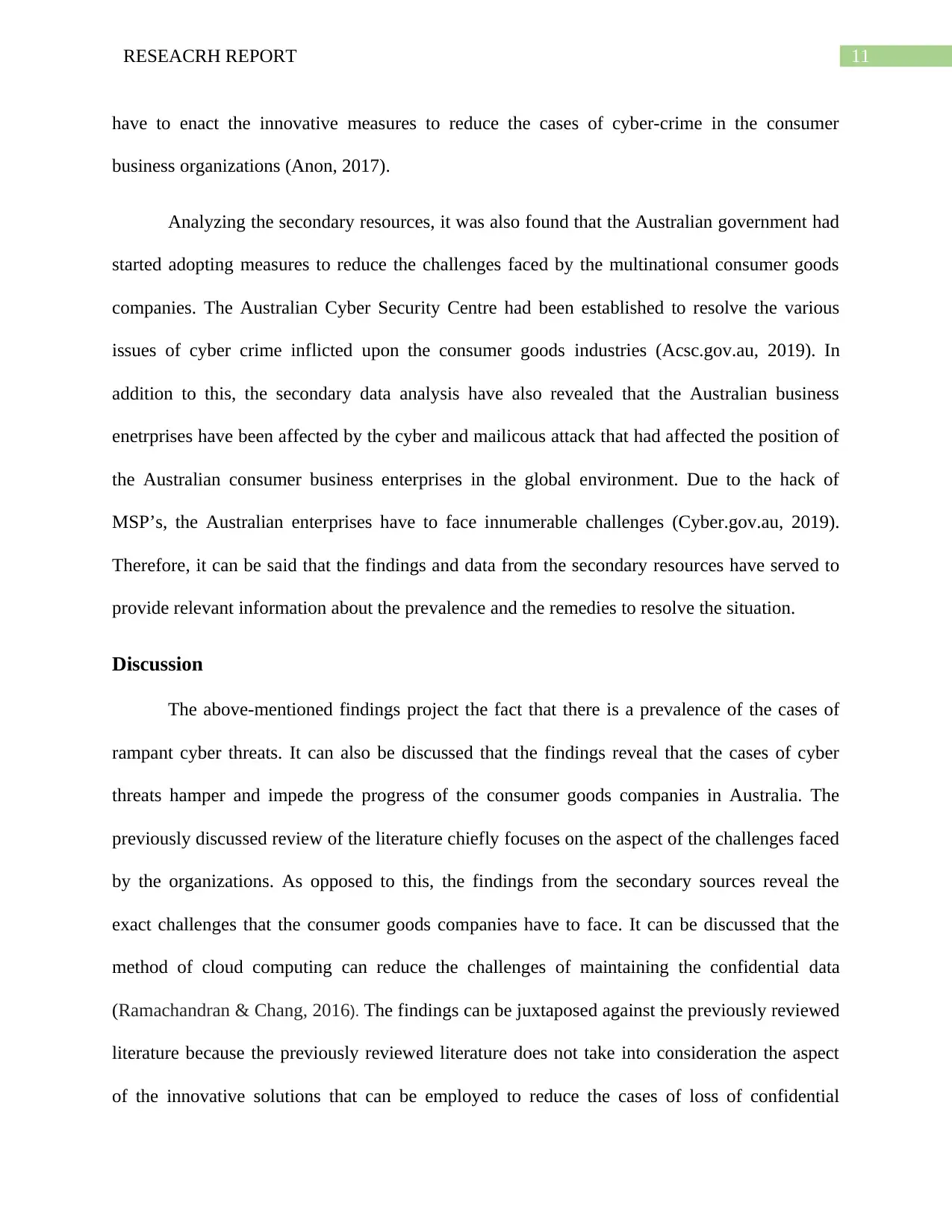
11RESEACRH REPORT
have to enact the innovative measures to reduce the cases of cyber-crime in the consumer
business organizations (Anon, 2017).
Analyzing the secondary resources, it was also found that the Australian government had
started adopting measures to reduce the challenges faced by the multinational consumer goods
companies. The Australian Cyber Security Centre had been established to resolve the various
issues of cyber crime inflicted upon the consumer goods industries (Acsc.gov.au, 2019). In
addition to this, the secondary data analysis have also revealed that the Australian business
enetrprises have been affected by the cyber and mailicous attack that had affected the position of
the Australian consumer business enterprises in the global environment. Due to the hack of
MSP’s, the Australian enterprises have to face innumerable challenges (Cyber.gov.au, 2019).
Therefore, it can be said that the findings and data from the secondary resources have served to
provide relevant information about the prevalence and the remedies to resolve the situation.
Discussion
The above-mentioned findings project the fact that there is a prevalence of the cases of
rampant cyber threats. It can also be discussed that the findings reveal that the cases of cyber
threats hamper and impede the progress of the consumer goods companies in Australia. The
previously discussed review of the literature chiefly focuses on the aspect of the challenges faced
by the organizations. As opposed to this, the findings from the secondary sources reveal the
exact challenges that the consumer goods companies have to face. It can be discussed that the
method of cloud computing can reduce the challenges of maintaining the confidential data
(Ramachandran & Chang, 2016). The findings can be juxtaposed against the previously reviewed
literature because the previously reviewed literature does not take into consideration the aspect
of the innovative solutions that can be employed to reduce the cases of loss of confidential
have to enact the innovative measures to reduce the cases of cyber-crime in the consumer
business organizations (Anon, 2017).
Analyzing the secondary resources, it was also found that the Australian government had
started adopting measures to reduce the challenges faced by the multinational consumer goods
companies. The Australian Cyber Security Centre had been established to resolve the various
issues of cyber crime inflicted upon the consumer goods industries (Acsc.gov.au, 2019). In
addition to this, the secondary data analysis have also revealed that the Australian business
enetrprises have been affected by the cyber and mailicous attack that had affected the position of
the Australian consumer business enterprises in the global environment. Due to the hack of
MSP’s, the Australian enterprises have to face innumerable challenges (Cyber.gov.au, 2019).
Therefore, it can be said that the findings and data from the secondary resources have served to
provide relevant information about the prevalence and the remedies to resolve the situation.
Discussion
The above-mentioned findings project the fact that there is a prevalence of the cases of
rampant cyber threats. It can also be discussed that the findings reveal that the cases of cyber
threats hamper and impede the progress of the consumer goods companies in Australia. The
previously discussed review of the literature chiefly focuses on the aspect of the challenges faced
by the organizations. As opposed to this, the findings from the secondary sources reveal the
exact challenges that the consumer goods companies have to face. It can be discussed that the
method of cloud computing can reduce the challenges of maintaining the confidential data
(Ramachandran & Chang, 2016). The findings can be juxtaposed against the previously reviewed
literature because the previously reviewed literature does not take into consideration the aspect
of the innovative solutions that can be employed to reduce the cases of loss of confidential
⊘ This is a preview!⊘
Do you want full access?
Subscribe today to unlock all pages.

Trusted by 1+ million students worldwide
1 out of 17
Related Documents
Your All-in-One AI-Powered Toolkit for Academic Success.
+13062052269
info@desklib.com
Available 24*7 on WhatsApp / Email
![[object Object]](/_next/static/media/star-bottom.7253800d.svg)
Unlock your academic potential
Copyright © 2020–2025 A2Z Services. All Rights Reserved. Developed and managed by ZUCOL.





